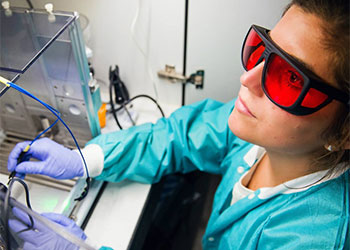Dr. Jennifer Evans' Research
Dr. Evans' Research Site
Nearly every cell in your body contains a clock that tracks time of day. These circadian clocks program daily rhythms in behavior and physiology to ensure that biological processes occur at the right time of day. In mammals, the circadian system is a collection of biological clocks regulated by a master clock within the brain, known as the suprachiasmatic nucleus (SCN). As the master clock, the SCN controls clocks located throughout the brain and body so that they are optimally timed relative to one another and the external environment. Recent work indicates that disrupted clock function is linked to a wide variety of health disorders, including depression, learning deficits, cardiovascular disease, obesity, and cancer. Our laboratory investigates the functional organization of the circadian system in mammals, with the ultimate goal of gaining mechanistic insight that can be used to develop new therapeutic approaches for these health risks.
Towards this end, we focus on several key questions:
- How do SCN neurons communicate with one another?
- How does the SCN control other tissues of the body?
- How is the circadian system altered by changes in the environment (e.g., shiftwork, jetlag, seasons) and during disease states (e.g., addiction, neurodegeneration)?
- Are changes in clock function directly linked to pathology?
- What intrinsic and extrinsic factors increase the flexibility of the circadian system?
Selected Publications
-
Joye DAM, Rohr KE, Suenkens K, Wuorinen A, Inda T, Arzbecker MU Mueller E, Huber A, Pancholi H, Blackmore MG, Carmona-Alcocer V, Evans JA (2023). Somatostatin regulates central clock function and circadian responses to light. PNAS. 2;120:e2216820120.
-
Rohr KE, Inda T, & Evans JA (2022). Vasopressin resets the central circadian clock in a manner influenced by sex and vasoactive intestinal polypeptide. Neuroendocrinology.112:904-916.
-
Joye DAM, Evans JA (2022). Sex differences in daily timekeeping and circadian clock circuits. Seminars in Cell & Developmental Biology, 126:45-55.
-
Carmona-Alcocer V, Rohr KE, Joye DAM, Evans JA (2020). Circuit development in the master clock network of mammals. Eur J Neurosci, 51:82-108.
-
Rohr KE, Pancholi H, Haider S, Karow C, Modert D, Raddatz NJ, Evans J (2019). Seasonal plasticity in GABAA signaling is necessary for restoring phase synchrony in the master circadian clock network. Elife. doi: 10.7554/eLife.49578
-
Stagl M, Bozsik M, Karow C, Wertz D, Kloehn I, Pillai S, Gasser PJ, Gilmartin MR, Evans JA (2018). Chronic stress alters adrenal clock function in a sexually dimorphic manner. J Mole Endo, 60:55-69.


